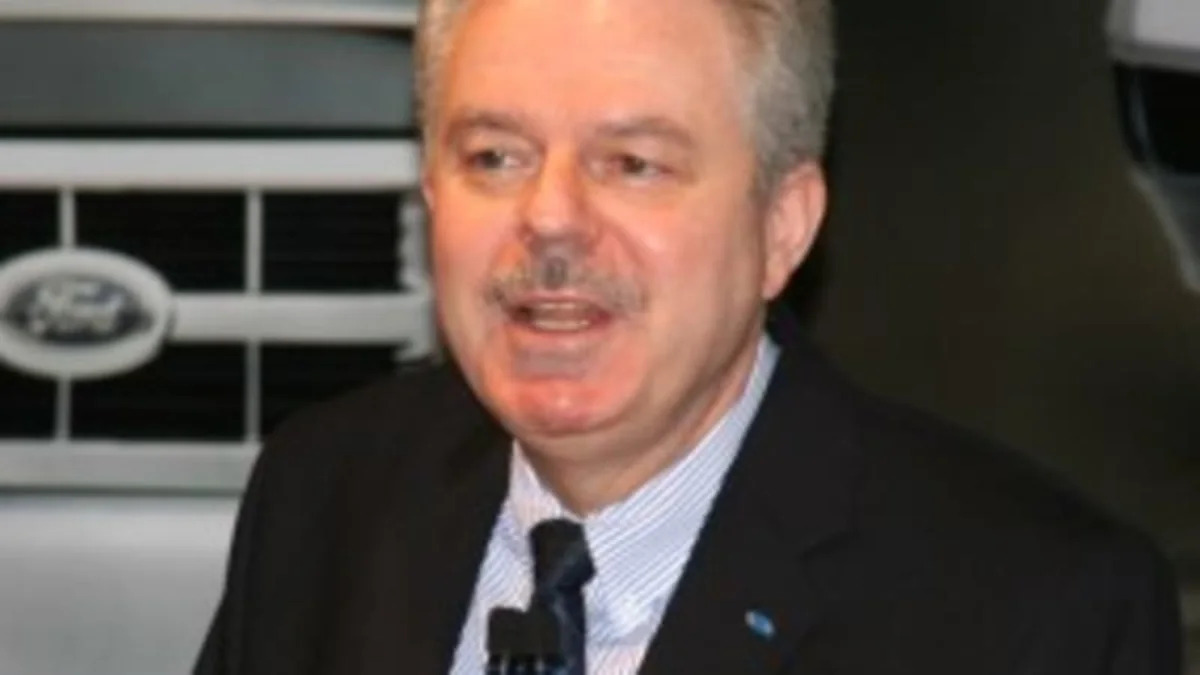 During the Ford 2008 model year preview at their Dearborn Development Center Friday, Group VP for Product Development Derrick Kuzak spoke about the changes that are being made to improve efficiency at Ford. Last January at the Detroit Auto Show, Ford showed off the Lincoln MKR concept which featured a new version of the corporate 3.5L V-6 dubbed Twin-Force.
During the Ford 2008 model year preview at their Dearborn Development Center Friday, Group VP for Product Development Derrick Kuzak spoke about the changes that are being made to improve efficiency at Ford. Last January at the Detroit Auto Show, Ford showed off the Lincoln MKR concept which featured a new version of the corporate 3.5L V-6 dubbed Twin-Force.
While the styling of the Lincoln concept may or may not appear in production, the technology on its engine apparently will be the cornerstone of Ford's efforts to improve the efficiency of their upcoming gasoline engines over the next few years. Ford will be following a similar path to Volkswagen's recent TSI engine range in Europe, by combining smaller displacement engines with turbocharging, direct fuel injection and advanced variable valve timing systems.
Continue reading after the jump.

According to Kuzak, ICEs can approach the efficiency of diesel engines with the twin-force technology without having to use the expensive exhaust after-treatment systems that clean diesels require to meet Tier 2 Bin 5 requirements. Ford plans to add Twin-Force to a range of four- and six- cylinder engines across many of their models by the 2011 model year. Unfortunately, Ford is again trailing behind on this front.
Volkswagen already has a several TSI engines on their European models and even GM has the same concept on the engine currently used in the Pontiac Solstice GXP and Saturn Sky Red-Line. As GM has shown the technology works with the turbo DI engine getting 2mpg better fuel economy while still producing 83hp more. An even smaller displacement engine like VW uses would be even more efficient.
All of Ford's future engines will be designed to accommodate Twin-Force which will also make them better suited to operating as flex-fuel engines. Because of ethanol's lower energy density but higher octane compared to gasoline, turbocharged engines that can vary boost pressure can take better advantage of the biofuel as Saab has demonstrated with their BioPower engines in Europe.
Getting power from the engine to the wheels is another area Ford will be addressing with new PowerShift transmissions. PowerShift is Ford's brand name for dual-clutch gearboxes similar to - you guessed it - the VW DSG units. Zukak didn't say when these would appear but it will likely be in the next couple of years. Ford also plans to expand availability of conventional six-speed automatics to all of their product lines in the same time frame.
The software side of powertrain controls is also being optimized to do things like shut off fuel flow more aggressively during deceleration while maintaining driveability. Battery management technology learned from hybrid development can also be applied to conventional vehicles to balance electrical loads from accessories and the battery state of charge. Even with a conventional drivetrain, closer monitoring of the battery could reduce parasitic losses by reducing the draw on the alternator. Using electrical rather than mechanical assist systems like electric power steering will also help reduce parasitic losses since the systems only draw power when needed instead of continuously, like with a hydraulic assist.
Hybrid drive applications will also be expanded in the next couple of years with a hybrid version of the Fusion and Milan due to be introduced at either the Los Angeles or Detroit Auto Shows and production availability mid-way through the 2008 model year. A hybrid version of the Edge crossover is coming as well although Ford isn't saying when.
Following the presentations, I spoke to Derrick and asked about some of the things he didn't discuss such as hybrid applications in their full size trucks. Unfortunately he was non-committal on this question declining to comment on unannounced products. Ford does have a light duty diesel V-8 coming in the 2009 F-150, which will probably make its way into the Expedition as well. As far as series hybrid systems like the HySeries drive that's being demonstrated in the Edge, again there was no commitment.
For smaller cars, Ford seems to be more committed to Twin-Force than diesels because of the much lower cost and nearly equal fuel economy. However with the global platforms Ford is using for new vehicles they are prepared to bring small clean diesels to the US market if it looks like the demand is there. So it appears that Ford will be watching the acceptance of all the upcoming diesel models from Volkswagen and Chrysler before making a US diesel commitment.


Sign in to post
Please sign in to leave a comment.
Continue